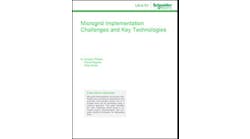African Campus Gets New Life with Microgrid Powered by Batteries and Solar Panels
Girls in Malawi, Africa now have a chance to get a good education thanks to a new microgrid. A solar array, capable of producing 6.6 kW during peak, will electrify the school campus, providing the lights and the energy to run computers, printers and TV screens.
The “Sokola” school campus is in a mountainous area in Chitipa, Northern Malawi and it has more than 250 students, teachers and staff. In this area of Chitipa, only 1% of the people have access to electricity. The surrounding villages, in fact, must use flashlights and lanterns for lighting in the evening.
So how did the Sokola school modernize? Joanna Gentilli, who is the solar designer in the project and who heads up a San Francisco-based social enterprise company called African Mini Grids told Microgrid Knowledge that it is using a modern 10 kWh battery that has a 30-year life and is made by Tesvolt.
Tesvolt is a German company that works closely with SMA, an inverter company for solar microgrids and minigrids. SMA and Tesvolt systems are configured to work together to produce a seamless option. Tesvolt uses Samsung SDI lithium cells to create a high voltage battery.
What makes this battery superior to earlier iterations used in Malawi, she adds, is that it can withstand the African heat. One of the big challenges for solar in Malawi is that the most commonly sold lead acid batteries last on average 1-3 years, meaning that developing communities are constantly re-purchasing batteries, contributing in some communities to a cycle of poverty. To have a battery that lasts 30 years is a game changer for the communities. Tesvolt uses NMC, or nickel manganese cobalt oxide, also found in Tesla’s Powerwall for solar storage in buildings.
Opening doors, connecting people
It is so new that only one country in the whole African continent sells Tesvolt, making it difficult to import to Malawi.
When bringing this new technology to places like Malawi, it is often difficult to find many companies that have had experience installing either SMA or Tesvolt.
“There are a lot of talented installation companies in Africa,” Gentili explained. “But they need to get the training and to do so, many would need to travel to another country. Conversely, there are a lot of companies all over the world that would like to break into the African market. And customers want better systems too.”
She added: “We are developing a platform, African Mini Grids, that connects installation companies all over the world with customers that would like to have these projects. African installation companies love it, because they can now offer high performance solar systems to their customers. It is a way to open doors, and it is a gateway to help people connect.”
For example, for the Sokola project, Sustain Solar from Cape Town was selected to pre-configure and install a solar system into an insulated and ventilated container. BNG Electrical, a Malawian solar and electrical installation company, was contracted to install the solar panels, distribute the power across campus, and wire the inside of all the buildings.
When the containerized solar system arrived in Chitipa, it was simply “plugged” in, and the whole school lit up. “It was a magical moment,” says Gentili.
Scaling up microgrid projects across Africa
As for the Sokola school, Peachtree Church from Atlanta Georgia is the sponsor. It is the one of the largest Presbyterian church in the United States. It has been sponsoring hundreds of African students with tuition and room and board for the past ten years, many of whom go on to get electrical and solar installation degrees.
This year, Peachtree has sponsored 200 students, building the girls their own dormitory — in addition to the first-ever solar microgrid for the school campus. The surrounding villages donated 400,000 bricks for the dormitory, and they housed and fed workers for one year. Importantly, technical school graduates of Peachtree’s program were hired to help build the dormitory, wire the campus and install the solar system.
“How do you make microgrids available and scale up?” asks Gentili. “How do you make more of these connections between installers and customers? By bringing collective talent together, each leveraging what the other brings to the table, thereby opening up doors for better and better systems to be installed.”
Wow
“I think a lot of organizations that work in Africa focus on the quality of the products,” she adds. “But it is also the quality of the installation and getting trained. I think when you can bring in outside expertise and up-skill the local talent, you will open up doors and raise quality. It’s part of the accelerant.”
Microgrids are the technology of the future for Africa. And the commitment that folks like Gentilli, and at Peachtree, have to bringing power to the continent is an important ingredient.
“The microgrid system at the school has been working beautifully and it is so efficient,” adds Rick Armstrong of Peachtree. “What a feeling it was to turn on the lights for the first time and to think that they would be on for the next 30 years. Wow.”
Track news about microgrids in Africa. Subscribe to the free Microgrid Knowledge newsletter.








